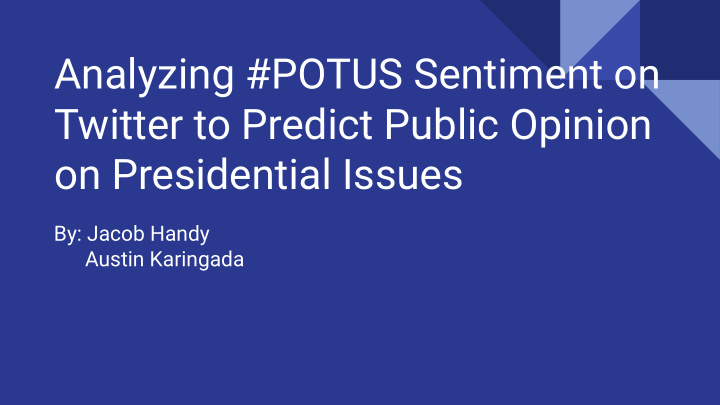



Analyzing #POTUS Sentiment on Twitter to Predict Public Opinion on Presidential Issues By: Jacob Handy Austin Karingada
Project Description ● Goal: predict public opinion on a presidential policy by searching for sentiment patterns in past tweets using #POTUS. ● Purpose: analyze twitter data with the Naïve Bayes model and search for patterns in keywords and the associated sentiment. Related work: Predict popular trends in the #metoo movement & a study that identified ● sentiment using the presence of emojis
ML methods ● Naive Bayes: ● Support Vector Machines: ○ A naive Bayes classifier is an algorithm ○ supervised learning models that analyze that uses Bayes' theorem to classify data used for classification and regression objects. analysis. Naive Bayes classifiers assume strong, or ○ naive, independence between attributes of data points. an SVM training algorithm builds a model ○ that assigns new examples to one category or the other, making it a non-probabilistic binary linear classifier ● One-Hot Encoding: A one hot encoding is a representation of ○ categorical variables as binary vectors.
Collecting the data 1. We used a Twython query with parameters: a. Searching for #POTUS b. Switch between mixed and recent results c. 100 tweets at a time d. Tweets in english 2. Preprocessed the tweets to be used nicer 3. One-hot encoded data into dictionary of id, classes, and sentiment 4. Wrote dictionary to csv file without label and id for calculating
One hot encoding ● Presence of keyword marked as 1, while not present is 0 Positive sentiment is 1, negative is 0 ●
Example table ID Trump Obama #BackfireTump 2020 Mueller Impeach #Democrats Russia Sentiment 6 0 1 0 0 1 0 0 0 1 17 1 0 0 0 0 0 0 0 1 34 1 0 1 0 0 0 0 0 0 49 0 0 0 0 0 0 0 0 1
Organized data for Naive bayes algorithm ● Due to the nature of writing a dictionary to a csv file, the data was needed by column, not rows We solved this issues by creating a list of lists that formatted the data ● column-by-column to a row each ● This transformation can be exemplified as the data being converted from the one-hot encoding slide to last slide’s table
Naive Bayes Algorithm ● Simple and effective classification algorithm Supervised learning ● Popular uses include: spam filters, text analysis and medical diagnosis. ● ● Assumes that the probability of each attribute belonging to a given class value is independent of all other attributes Calculates the probability of each instance of each class and selects the ● highest probability
Naive Bayes math
The process of Naive Bayes Before the prediction: Prediction: 1. Preprocess the data into the table format 1. Calculate probabilities using the equation from earlier on last slide 2. Split the data set with 67% for training set 2. Summarize all the probabilities for each and 33% for test set class 3. Separate data by classes to calculate the 3. Make a prediction based on the best statistics for each class probability 4. Calculate the mean 4. Test the probabilities with the actual 5. Calculate the standard deviation values 6. Collect the values 5. Get the accuracy as a percentage
67.55% Accuracy
Data Limitations 1. Twitter API plan:(free) Solved Limitations: a. 100 tweets/request 1. Variations: search first half of class word b. 30 requests/min c. 256 characters d. Last 30 days 2. Very bad misspellings 2. Punctuation: replaced punctuation with a. Ex: Muler != Mueller nothing(Ex: ‘ ’) 3. Lack of bigrams 4. Does not detect sarcasm 3. Capitalization: .lower() method
● Yes, sarcasm is a big problem in our algorithm. Our Greatest ● However, there is not a good way of detecting sarcasm as Limitation people aren’t even that good at it ● One way is to identify positive and negative words in one Sarcasm! string, but it is not very effective ● Research is ongoing with CNNs
Future Work ● Find most optimized algorithm between Naive Bayes and SVM SVM proved faster in a similar sentiment analysis project ○ Bernoulli Naive Bayes ● ○ Now that we dropped the neutral sentiment, the data is now binary Improves accuracy in the assumption that data is binary ○ Bigrams ● ○ Provides better context to the the sentiment
SVMs Supervised Learning ● Can be used for both regression and classification but is used mainly for ● classification ● Objective is to find a hyperplane in an N-dimensional space that distinctly classifies the data points. (N - the number of features)
Pros and Cons of SVM Pros Accuracy Works well on smaller cleaner datasets It can be more efficient because it uses a subset of training points Cons Isn’t suited to larger datasets as the training time with SVMs can be high Less effective on noisier datasets with overlapping classes
FAQ 1. How can we improve the accuracy? a. Due to the new nature of our one-hot encoded data, a Bernoulli Naive Bayes implementation would work better 2. Why weren’t bigrams implemented? a. We had problems implementing them as it complicated data formatting and we wanted to make sure we could implement individual keywords first 3. Why didn’t we upgrade our Twitter API plan? a. Because its $149 and we’re broke 4. How can we handle sarcasm? a. Addressed in slide 14, but CNN models are pre-trained and used to extract sentiment, emotion, and personality features which captures the context of information 5. What will be done between now and the report? a. Finish implementing the SVM algorithm and compare time and accuracies
References Twitter API. Go, Alec, et al. “Twitter Sentiment Classification Using Distant Supervision.” Cs.stanford.edu, Stanford University, cs.stanford.edu/people/alecmgo/papers/TwitterDistantSupervision09.pdf. Berwick, R. “An Idiot’s Guide to Support Vector Machines (SVMs).” Web.mit.edu, MIT, web.mit.edu/6.034/wwwbob/svm-notes-long-08.pdf. Rish, I. “An Empirical Study of the Naive Bayes Classifier.” Cc.gatech.edu, T.J. Watson Research Center, www.cc.gatech.edu/ isbell/reading/papers/Rish.pdf. Brownlee, Jason. “Naive Bayes Classifier From Scratch in Python.” Machine Learning Mastery , 31 Aug. 2018, machinelearningmastery.com/naive-bayes-classifier-scratch-python/. https://github.com/ryanmcgrath/twython
Questions?
Recommend
More recommend